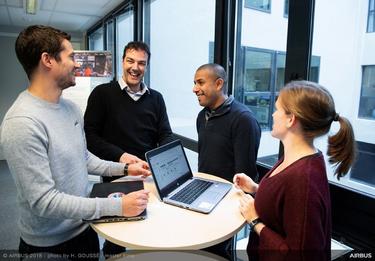With a workforce of some 134,000 people – and activities that range from the manufacture of aircraft, helicopters and spacecraft to delivering security and communications solutions – Airbus offers a true variety of career opportunities.
Adil Soubki, for example, is a data scientist at Airbus’ Flight and Integration Test Centre, a job created by the company a year ago. When flight test specialists cannot find the cause of an aircraft engine or system problem, they turn to Soubki.
Soubki and three data analyst colleagues work at an integrated grouping known as the Digital Factory Plateau in focussing on predictive maintenance, anomaly detection and root cause analysis. “Last year, we mainly worked on writing algorithms to detect abnormalities,” he says. “This year, our team is building a search engine for flight test and certification data.”

As an Airbus data scientist, Adil Soubki (second from right) relies on collaboration and dialogue with teammates and experts.
Timeline
-
7:30 a.m. > Trial and error
Lydie Pallarols, a hydraulic system test specialist, has provided Soubki with flight test campaign data, which he checks to establish whether a failure with the engine-driven pump aboard an in-service aircraft could have been predicted prior to delivery. “In this instance, the algorithm is creating a false alarm,” Soubki said. “It detects noise as abnormal behaviour, but that’s not the issue. The problem is heat.”
-
9:30 a.m. > Collaborative work
Soubki meets with his colleagues to discuss how the engine-driven pump’s parameters could be modified to enhance the failure prediction score and avoid false alarms. Data analysts rely on successful dialogue with experts and teammates – and in the case of technical hurdles, this can include Airbus’ Digital Transformation Office and Chief Technology Office.
-
11:30 a.m. > Flight test search engine
As work progress on the engine-driven pump issue, it is time for another project. Soubki is working with David Roussel on a flight test and certification search engine that would help locate parameters using keywords. “This would enable users to enter parameters at certain configurations – for example, at an altitude of 10,000 feet – to obtain comparison information from other flights under the same conditions,” Soubki explained.
-
3:00 p.m. > Success!
Soubki develops a new computer-based model for the engine-driven pump failure to detect the anomaly in data from flight test aircraft. “It shows the perfect split between bad and good performance, which is what we are looking for,” he stated. Soubki once again contacts Lydie Pallarols – the hydraulics specialist. Reviewing his data, she confirms the anomaly detection demonstrates that the problem stem from the engine-driven pump itself.
Soubki’s results are promising, according to Pallarols. “He generated an ultra-performing model that can open doors to other cases,” she added. “I’ve now asked him to run the algorithm on all production aircraft: in this way, we can obtain a clearer picture, as we will be analysing hundreds of flights.”
I love solving problems. I continuously learn more about aircraft because I work with specialists.
- Adil Soubki, a data scientist at the Flight and Integration Test Centre
